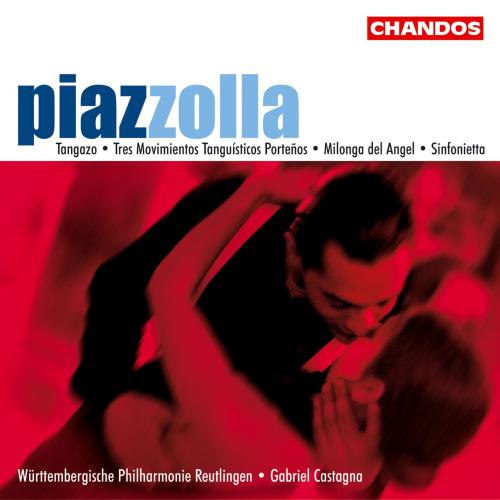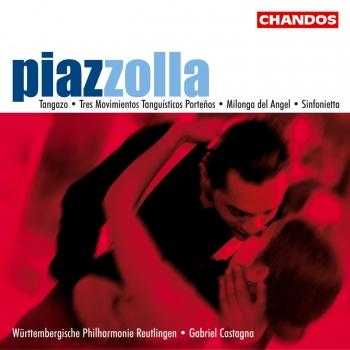
Piazzolla: Orchestral Works Wurttemberg Philharmonic Orchestra & Gabriel Castagna
Album info
Album-Release:
2003
HRA-Release:
17.10.2023
Label: Chandos
Genre: Classical
Subgenre: Concertos
Artist: Wurttemberg Philharmonic Orchestra & Gabriel Castagna
Composer: Astor Piazzolla (1921-1992)
Album including Album cover
- Astor Piazzolla (1921 - 1992): Tangazo, "Variations on Buenos Aires":
- 1 Piazzolla: Tangazo, "Variations on Buenos Aires" 14:31
- Tres movimientos tanguisticos porteñs:
- 2 Piazzolla: Tres movimientos tanguisticos porteñs: Tango No. 1. Allegretto 07:10
- 3 Piazzolla: Tres movimientos tanguisticos porteñs: Tango No. 2. Moderato 08:33
- 4 Piazzolla: Tres movimientos tanguisticos porteñs: Tango No. 3. Vivace 04:28
- Milonga del Angel:
- 5 Piazzolla: Milonga del Angel 06:44
- Sinfonietta:
- 6 Piazzolla: Sinfonietta: I. Dramatico 05:41
- 7 Piazzolla: Sinfonietta: I. Sobrio 06:11
- 8 Piazzolla: Sinfonietta: III. Jubiloso 03:49
Info for Piazzolla: Orchestral Works
Since the death of Astor Piazzolla in 1992, the popularity of his music has increased exponentially, and his works continue to appear on disc in countless arrangements for all manner of instrumental forces.
This recognition of the very special talent of one of the finest composers to have emerged from Latin America is well deserved - Piazzolla's melodic and harmonic gifts have an expressive potency all their own - but the way in which this burgeoning popularity has sometimes ridden rough-shod over the fine distinctions within his output is less welcome.
Piazzolla is credited with the reinvention of the tango, the century-old dance form endemic to Spanish-speaking America in general and to his native Argentina in particular, and, from the late-1950s onwards, for finding a new audience for that music.
But what is so fascinating about Piazzolla's development is the way that, from the start of his career, he straddled both art-music and dance cultures.
As a child he learnt to play the bandoneon, the special Latin form of the accordion, and from the age of 17 was a sought-after member of many of the leading tango bands in Buenos Aires.
His idol as a teenager was the great Argentinian songwriter Carlos Gardel, but he was fascinated by the the classical tradition too, and by Bach especially, and so took composition lessons with Alberto Ginastera, who introduced him to the music of Stravinsky and Bartok.
Piazzolla then won a scholarship to go to Paris to study with Nadia Boulanger, taking with him a whole portfolio of worthy orchestral pieces. It was Boulanger though who, belying her historical image as a hardline neoclassicist, recognised that Piazzolla's real gifts were very special and unclassifiable, and suggested that he return home to discover what the tango could offer.
The rest, as they say, is history: with his harmonic and rhythmic sophistication, Piazzolla revived a dance form that was dying on its feet, and with his own band, which went through numerous incarnations but always spotlighted its leader's acerbic bandoneon, he spread the gospel of tango nuevo around the world.
Yet he never quite cut his links with the concert hall; he continued to compose orchestral pieces and this very decently played collection is that rare thing nowadays, a Piazzolla disc in which everything is heard exactly as it was written, even if Milonga del Angel is the composer's own hazily sensuous orchestration of a piece that he first made famous with his sextet.
The roots of Piazzolla's "classical" style are clear in the Bartokian opening of the 1969 Tangazo, a set of variations in which he also finds ingenious orchestral equivalents for the spiky dissonances that characterised his own bandoneon playing.
In the set of three tangos he called Tres Movimientos Tanguisticos Portenos (1961), the treatment of the infinitely suggestive themes has a Stravinskian tang, while the Sinfonietta was one of the pieces Piazzolla took with him to Paris.
It's a bit too close to the music of his teacher Ginastera for my taste, but still fascinating as the starting point for a music that was to become so pungently personal. (Andrew Clements, The Guardian)
Württembergische Philharmonie Reutlingen
Gabriel Castagna, conductor
Gabriel Castagna
The Argentine conductor Gabriel Castagna began his musical studies in Buenos Aires and continued in the USA, where he studied at the Universities of Rochester, Cincinnati, Carnegie Mellon, Pittsburgh and Michigan. Among his teachers were Gustav Meier, Robert Page and Samuel Jones. He has participated in master-classes with Leonard Bernstein, Sergiu Celibidache and Max Rudolf and is the recipient of many awards and other distinctions. Devoted to promoting the symphonic works of Argentine composers, Gabriel Castagna has performed and recorded the music of Alberto Ginastera, Astor Piazzolla, among others.
This album contains no booklet.












